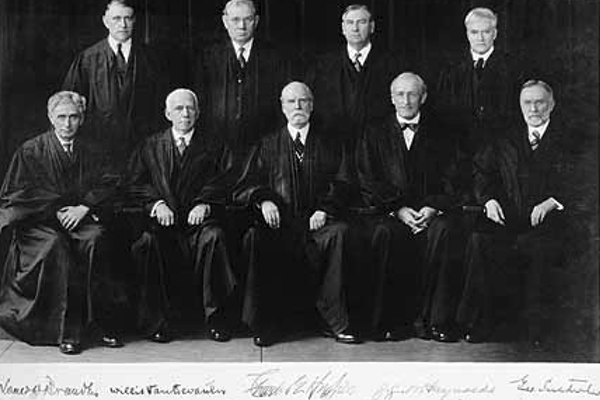FDR Was Right to Propose Enlarging the Court

Franklin Roosevelt rarely made political mistakes. But on February 5, 1937, he made one of the great blunders of his administration when he sent a message to Congress seeking a reorganization of the federal judiciary. Roosevelt sought to increase the number of justices on the Supreme Court, up to a total of fifteen, if justices over seventy years of age refused to retire. For every such non-retiring justice, the president would be permitted to appoint a new justice—potentially six new positions.
FDR was right when he asked for the authority; his mistake was not talking directly about why the expansion was needed. He argued that the courts were not effectively handling increasingly overcrowded dockets and that many judges, taking advantage of life tenure, were staying on the bench too long. “This brings forward the question of aged or infirm judges,” Roosevelt wrote Congress, “a subject of delicacy and yet one which requires frank discussion.”
These came across as sham arguments, and the president thereby lost credibility. The public knew right away that court efficiency and age were not the problems. The problem was the Supreme Court was trying its best to undo all the badly needed legislation passed under the New Deal to address the deepest depression the country had ever known.
FDR feared this conservative reaction—the drive to negate the New Deal—was about to get worse, even though he had just scored one of the greatest presidential election landslides in history in 1936.
What the president knew was that as prosperity returned the need for reform would wane and the accomplishments of the New Deal were at risk. As Stanford historian David M. Kennedy noted in his Oxford history, Freedom from Fear, the chief danger to the New Deal came from the Supreme Court. “Most ominous,” Kennedy wrote, “the threat of judicial nullification loomed over virtually every New Deal measure thus far enacted. The Supreme Court had already gutted many of the reform initiatives of the Hundred Days, notably NRA (National Recovery Act) and AAA (Agriculture Adjustment Act).”
Kennedy points out that Roosevelt had reason to set his sights on the Supreme Court and the federal bench. He had appointed no justice to the Court during his first term. Woodrow Wilson, his only recent Democratic predecessor, had nominated one liberal, Louis Brandeis, and one conservative, James McReynolds. Republican presidents had named the remaining seven justices. More, nearly 80 percent of the all judges sitting on federal courts had been appointed by Republican presidents.
Through a series of cases the Supreme Court threw out the National Industrial Recovery Act in Schecter Poultry Corporation (where owners violated wage and hour codes, not to mention sold diseased chickens), the Agricultural Adjustment Act in United States v. Butler (where a tax on processors went to pay farmers to limit production), and even a state law—the New York minimum wage law in Morehead v. New York ex rel. Tipaldo.
There was little question that the Social Security Act and the National Labor Relations Act, among others, were imperiled. The judicial assault, based on grandiose arguments about “freedom of contract,” challenged the very power of the national government to address the problems and disruptions of a modern industrial economy.
We have seen this phenomenon play out in our times. A financial emergency in 2008-2009 provided the basis for a Democratic president to pass, among other reforms, the Affordable Care Act providing insurance to millions who were uninsured. But as prosperity returned (and before the pandemic), conservatives organized to undo the ACA and have been singularly focused on its destruction. And despite the fact the Act barely survived a challenge in the Supreme Court, there is little question that Trump appointees including Justice Amy Coney Barrett will declare the ACA unconstitutional, to say nothing of potentially unwinding gay marriage and a woman’s right to choose.
Is it farfetched to see even Social Security as a target?
The case to expand the Court today differs somewhat from 1937. Life tenure in FDR’s time resulted in a highly conservative federal bench stubbornly holding on to power. Roosevelt believed older judges from earlier generations were not best equipped to adjust to modern realities. “Little by little,” he wrote, “new facts become blurred through old glasses fitted, as it were, for the needs of another generation; older men, assuming that the scene is the same as it was in the past, cease to explore or inquire into the present or the future.”
Today, expansion arises from what many perceive as the “theft” of a seat--if not two--on the Court. Republicans would not allow President Obama his right to appoint a justice in an election year and now have reversed course to permit President Trump a nominee just weeks before an election.
A Barrett confirmation will result in a 6-3 conservative majority when the nation does not begin to resemble that sort of political alignment. The only real remedy given Republican machinations is to restore balance by adding justices. As FDR pointed out, there is nothing immutable about the size of the Court. He reminded Congress: “The Supreme Court was established with six members in 1789; it was reduced to five in 1801; it was increased to seven in 1807; it was increased to nine in 1837; it was increased to ten in 1863; it was reduced to seven in 1866; it was increased to nine in 1869.”
What FDR needed to do in 1937 was to say plainly his real reasons for increasing membership on the Court. Where a court decidedly ignores the will of the people and plays a nullifying role to critical national legislation, it is a political and constitutional option for a president and Congress to increase the size of the Court so that it will be representative of the nation as a whole.
Lifetime appointments should not mean that a badly out-of-step group of judges can overrun the will of the people.